Winter season outdoor camping is a fun and daring experience, however it requires appropriate gear to guarantee you stay cozy. You'll need a close-fitting base layer to catch your body heat, in addition to a protecting jacket and a water-proof shell.
You'll also need snow stakes (or deadman anchors) buried in the snow. These can be tied using Bob's smart knot or a routine taut-line hitch.
Pitch Your Tent
Winter camping can be an enjoyable and daring experience. Nonetheless, it is necessary to have the correct equipment and know how to pitch your outdoor tents in snow. This will certainly protect against cool injuries like frostbite and hypothermia. It is likewise essential to eat well and stay hydrated.
When setting up camp, ensure to pick a website that is protected from the wind and devoid of avalanche danger. It is also a good idea to load down the location around your outdoor tents, as this will help in reducing sinking from temperature.
Before you set up your tent, dig pits with the same size as each of the support points (groundsheet rings and individual lines) in the facility of the tent. Fill these pits with sand, rocks or perhaps stuff sacks full of snow to small and secure the ground. You might additionally wish to consider a dead-man support, which entails tying camping tent lines to sticks of wood that are buried in the snow.
Pack Down the Area Around Your Camping tent
Although not a requirement in a lot of locations, snow stakes (also called deadman anchors) are an excellent addition to your outdoor tents pitching set when camping in deep or pressed snow. They are basically sticks that are developed to be hidden in the snow, where they will certainly ice up and develop a solid anchor factor. For finest outcomes, make use of a clover drawback knot on the top of the stick and hide it in a few inches of snow or sand.
Set Up Your Outdoor tents
If you're camping in snow, it is a great concept to utilize a camping tent developed for wintertime backpacking. 3-season camping tents function great if you are making camp listed below tent setup tree line and not expecting especially harsh climate, however 4-season outdoors tents have stronger poles and materials and offer even more security from wind and hefty snowfall.
Make certain to bring adequate insulation for your resting bag and a warm, dry inflatable floor covering to sleep on. Blow up floor coverings are much warmer than foam and aid stop chilly spots in your tent. You can additionally include an additional mat for sitting or cooking.
It's additionally an excellent idea to set up your tent near an all-natural wind block, such as a group of trees. This will make your camp extra comfortable. If you can not find a windbreak, you can produce your own by digging openings and burying items, such as rocks, tent risks, or "dead man" supports (old camping tent individual lines) with a shovel.
Tie Down Your Camping tent
Snow risks aren't needed if you use the best strategies to secure your tent. Hidden sticks (maybe accumulated on your approach hike) and ski posts function well, as does some variation of a "deadman" buried in the snow. (The idea is to develop a support that is so strong you will not have the ability to draw it up, despite a great deal of effort.) Some suppliers make specialized dead-man supports, yet I like the simplicity of a taut-line hitch tied to a stick and afterwards hidden in the snow.
Be aware of the terrain around your camp, particularly if there is avalanche threat. A branch that falls on your tent can harm it or, at worst, wound you. Likewise be wary of pitching your outdoor tents on an incline, which can trap wind and bring about collapse. A protected area with a low ridge or hill is far better than a steep gully.
